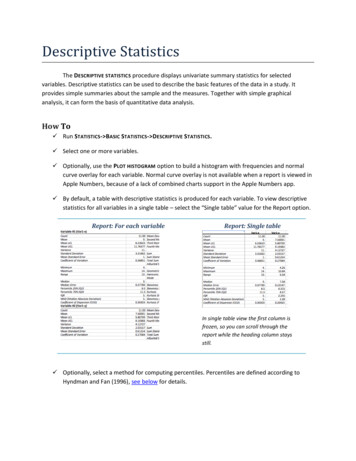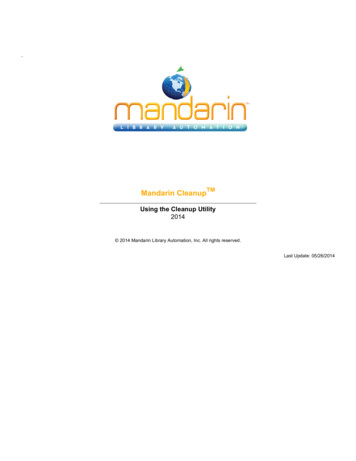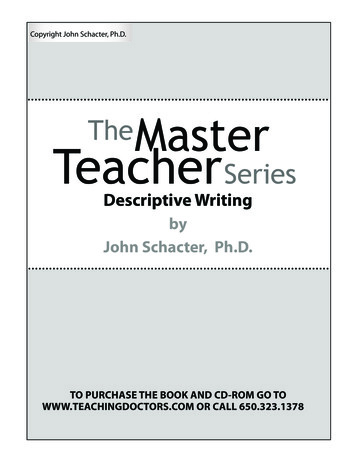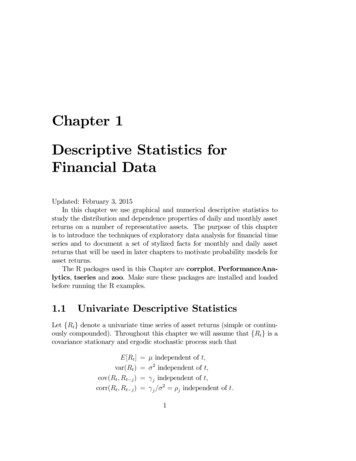
Transcription
DESCRIPTIVE CATALOGING GUIDELINES FORPRE-MEIJI JAPANESE BOOKSLast revised Sept. 1, 2007Prepared by:Isamu Tsuchitani, Library of CongressReviewed by:Toshie Marra, University of California, Los Angeles,Hideyuki Morimoto, Columbia University,Reiko Yoshimura, Freer Gallery of Art/Arthur M. Sackler Gallery,Smithsonian InstitutionHisako Rogerson, Library of CongressManae Fujishiro, Library of Congress
CONTENTS:INTRODUCTION . 30. GENERAL RULES . 50A. Scope and purpose . 50B. Reference sources for cataloging . 50C. Language and script. 60D. The basic description . 80E. Chief source of information (title page) . 91. TITLE AND STATEMENT OF RESPONSIBILITY AREA . 101A. Title proper. 101B. Other title information. 111C. Items without a collective title. 121D. Statement of responsibility. 132. EDITION AREA . 152A. Sources of information. 152B. Edition statement. 153. MATERIAL SPECIFIC DETAILS AREA . 164. PUBLICATION, ETC., AREA . 164A. Sources of information. 164B. Place of publication . 174C. Publisher statement. 184D. Date of publication/production . 204E. Date of impression. 225. PHYSICAL DESCRIPTION AREA . 225A. Sources of information. 225B. Extent. 235C. Illustration . 285D. Size and format. 305E. Accompanying material. 326. SERIES AREA . 327. NOTE AREA. 337A. General instructions. 337B. Preliminary rule . 337C. Notes . 35BASIC REFERENCE MATERIALS. 45GLOSSARY . 492
INTRODUCTIONIn May 1999, the Library of Congress began two major projects related to the AsianDivision’s holdings of printed books, bound manuscripts, and scrolls produced in Japan before1868: 1) a project led by the Japanese Rare Book Team headed by Prof. Kenji Watanabe ofRikkyo University to compile a bibliography of these holdings enabling scholars and readersworldwide to have access to the Division’s Japanese rare books collection; and 2) a catalogingproject led by the Library’s Japanese Team to create online records for these holdings in theRLIN database. The outcome of the former was a publication of Beikoku Gikai Toshokan zōNihon kotenseki mokuroku or Catalog of Japanese rare books in the Library of Congress in 2003.Excluded in the above catalog are over 300 titles of works on art which were included in aseparate publication in 2002, Pre-Meiji works on Japanese art in the Library of Congresscompiled by Mr. Shojo Honda and Prof. Sandy Kita.Related to the latter project, a set of special guidelines for cataloging these materials wereoriginally drafted in Japanese by Ms. Manae Fujishiro in consultation with the Library’s RareBook Cataloging Team. These Japanese guidelines were written initially for LC staff only, butlater in 2001 the Japanese Team decided to additionally compile English guidelines in responseto the needs expressed by catalogers outside the Library. Since then, Mr. Isamu Tsuchitani hasbeen in charge of compiling English guidelines for cataloging pre-Meiji Japanese books.Previously, in 2000, the Committee on Japanese Materials of the Council of East AsianLibraries (CEAL) established the Subcommittee on Japanese Rare Book Cataloging Guidelines.One of the Subcommittee’s initial charges was to draft cataloging guidelines for Japanese rarebooks, which was later modified to assist LC’s project in compiling English catalogingguidelines for pre-Meiji Japanese books. One of the noteworthy results of the collaborationbetween the Library of Congress and the Subcommittee relates to the LC-CEAL Q&A Sessionsfor CJK Rare Book Cataloging held at the Library of Congress on April 1, 2002, for which theSubcommittee compiled questions for cataloging Japanese rare books. The answers to thesequestions were prepared and delivered at the session by Ms. Fujishiro and Mr. Tsuchitani, inconsultation with Ms. Elizabeth A. Robinson and Ms. Debra D. Wynn of the Rare Books Teamof the Library of Congress.Mr. Tsuchitani’s project of compiling English guidelines for cataloging pre-Meiji Japanesebooks took several years, partly because Descriptive Cataloging of Rare Books (DCRB) whichhe must have based upon for his project was scheduled to be revised. Unfortunately, however,Mr. Tsuchitani’s retirement has preceded the revision of DCRB. On January 4, 2006, Mr. IsamuTsuchitani retired from the Library of Congress after working over 44 years. Subsequently, thedraft file of the guidelines written by Mr. Tsuchitani was passed over the Subcommittee onJapanese Rare Books, formerly known as Subcommittee on Japanese Rare Book CatalogingGuidelines, which eventually decided to review the guidelines and make them available to all thecatalogers in North America. In this special task, the Subcommittee asked its former memberMs. Reiko Yoshimura to participate.3
The reviewers of Descriptive Cataloging Guidelines for Pre-Meiji Japanese Books wouldlike to express profound appreciation to Mr. Tsuchitani who devoted much of his time inpreparing these cataloging guidelines to be applied specifically to Japanese printed books andbound manuscripts produced in Japan before 1868. We owe enormous appreciation to Ms.Manae Fujishiro and Ms. Hisako Rogerson as well who have diligently cataloged the Library’srare Japanese holdings for many years and contributed abundant examples included in theguidelines. These two experienced catalogers have already created over 5,400 catalog recordsonline to facilitate access to the renowned Library’s Japanese rare book collection for all theusers world-wide.March 25, 2006Toshie MarraUniversity of California, Los Angeles,Hideyuki MorimotoColumbia University, andReiko YoshimuraFreer Gallery of Art/Arthur M. Sackler Gallery,Smithsonian Institution4
0. GENERAL RULESContents:0A. Scope and purpose0B. Reference sources for cataloging0C. Language and script0D. The basic description0E. Chief source of information (title page)0A. Scope and purposeThese guidelines are based on the 1998 Revision of the Anglo-AmericanCataloguing Rules, Second Edition (referred to hereafter as AACR 2) andthe Descriptive Cataloging of Rare Books (referred to hereafter as DCRB),2nd edition. The guidelines provide instructions for cataloging Japaneseprinted books, manuscripts, scrolls, handmade albums, single-sheetpublications, and Chinese books produced in Japan before the introductionof machine printing in the nineteenth century. They may be used indescribing any books, however, particularly those produced by hand or bymethods continuing the tradition of the hand-produced book.Cataloging old Japanese books presents situations not ordinarilyencountered in the cataloging of the usual modern book and because oftheir rarity, value, or interest make special description necessary ordesirable and may require details of description beyond what is requiredfor the more ordinary book in order to identify significant characteristics.These details are important for two reasons. They permit a readyidentification of copies of the book (e.g., as editions, impressions, orissues), and they provide a more exact description of the book as anartifact.These guidelines may be applied selectively, according to theadministrative policy of the institution, which may choose to catalog someor all of its holdings at a more detailed level of description than thatprovided for in AACR 2.0B. Reference sources for catalogingAlthough the guidelines for cataloging Japanese books and boundmanuscripts published in Japan before 1868 are based, as fully as possible,within the framework of AACR 2 and DCRB, the traditional Japanese rare5
book cataloging practice (e.g. Nagasawa Kikuya’s Wa-Kan koshomokurokuhō) and the Cataloging Guidelines for Creating Chinese RareBook Records in Machine-Readable Form, 2000 (Research LibrariesGroup) were also taken into consideration.In the absence of a rule in the guidelines, the appropriate rule in AACR2,DCRB, and LC Rule Interpretations is applied in cataloging these books.0C. Language and scriptGive Romanized and original script for each field, with the exception ofphysical description (Romanized only), the informal notes and local notes(English, Romanized and/or original script), and content notes(Romanized and/or original script).Give Romanization in the modified Hepburn system as employed inKenkyusha’s New Japanese-English Dictionary (3rd and later editions)*and follow the ALA-LC Romanization Tables for word division.*The reading of Japanese words follows the reading given in referencesources where the usage of standard authorities has established a particularreading for a particular word, name, or book title, etc.In case of Chinese works produced in Japan, if the text has Japanesereading marks treat it as Japanese with Chinese text; if the text has noJapanese reading marks, treat it as Chinese, i.e. transliterate the title properin Chinese with variant reading in Japanese. However, if the title of workis supplied by Japanese compiler/editor, title proper should betransliterated in Japanese, with variant reading in Chinese.Transcription of characters:Hentai-gana (変体仮名)/Manʾyō-gana (万葉仮名)Transcribe Hentai-gana as Hiragana in the title and statement ofresponsibility area, if it is written in cursive style (くずし字 kuzushiji),and use the note area for explanation.Transcribe Manʾyō-gana or Hentai-gana in printed style (楷書 kaisho) asChinese characters in the title and statement of responsibility area.6
狂歌 うひまなびNote: Title in Hentai-gana: 狂歌 宇比ま奈飛But not宇津保 物語If the above guidelines are not helpful consult reference sources.Itaiji (異体字)Replace non-standard character forms not in MS-IME by aboldface equal symbol “ ” (or without it when this symbol is notavailable in the cataloging utility) followed by the standard character insquare brackets. Add explanation in a note, if useful. Ignore commongraphic variants.年寄 [介]そへ 心得 之 事Note: Third character in title not available in MS-IME; consists of手 (left) and 介 (right)Odoriji, Kurikaeshi Kigō (踊字・ 繰り返し記号)Transcribe Odoriji (repeating symbol) for Chinese character “々” as itappears in the title proper as given on the chief source of information butreplace repeating symbols for Hiragana and Katakana suchas ゝ, ゞ, ヽ, ヾ, etc. with their respective characters and explain in anote.夫々Butかがみ (Title appears as かゞみ)Note: Repeating symbol used in title.Use boldface equal symbol “ ” [geta] or the Japanese reading of thecharacter in square brackets to replace Chinese characters that are not inMS-IME. Use the note area to provide explanations of the missing7
characters.陳 通鑑・商 輅 綱目Or,陳[Jing] 通鑑・商 輅 綱目Note: Missing character Morohashi 14804**The number is the character identification number of Morohashi’sDai Kan-Wa jiten.0D. The basic description0D1. The description must always include the following elements,regardless of the completeness of the information available: title proper,date of publication, extent of item, size of item. Also include otherelements of description as set out in the following rules, if available andappropriate to the chosen level of description.0D2. In general, base the description on the copy in hand. If this copy isknown to be imperfect, however, and the details of the description of acopy without the imperfection(s) can be determined with certainty, rely onthese details, employing the conventions for bracketing as if theimperfection(s) did not exist. In such cases, the details should be verifiedby examining one or more additional copies, or be referring to adescription in a reliable bibliography, preferably one based on anexamination of several copies (e.g. Kokusho sōmokuroku, Kotenseki sōgōmokuroku, etc.). Cite the source used for the description in a note.If the copy being cataloged is imperfect and no reliable evidence of thenecessary details is available, describe the copy as it is. Use the mark ofomission enclosed in square brackets to show lacunae in the source ofinformation if this helps to explain the incompleteness of the transcription.If missing or obscured characters can be reconstructed with some certainty,include these in the transcription, enclosing them in square brackets. Usethe note area to justify such additions and to provide explanations,conjectural readings of the data, etc.0D3. Use the square “囗”symbol to replace an omitted or obscurecharacter. In Romanized field, use mark of omission in square brackets8
([ ]) for each missing or obscure character. However, supply the mark ofomission in one set of square brackets if missing information is insuccession. Use the note area for explanation.濃州 何郡 囗村 五人組 御仕置帳Nōshū nani-gun [ ] mura goningumi oshiokichōNote: One character illegible in title濃州 何囗囗囗 五人組 御仕置帳Nōshū nani [ ] goningumi oshiokichōNote: Three characters illegible in title0E. Chief source of information (title page)The chief source of information for a publication and a manuscript is thetitle page, or, if there is no title page, the source from within the item thatis used as a substitute for it.For items without a title page, if a single title proper is available in a singlesource within the item, use this source as the title page substitute. If thesame title proper is available in more than one source within the item,choose as the title page substitute the source that supplies the mostadditional information. If the above mentioned provision does not settlethe issue, choose the title page substitute one of the following, in this orderof preference:a) Caption title (巻首題 kanshudai)b) Title from table of contents (目次題 mokujidai)c) End title (尾題 bidai)d) Title from preface (序題 jodai)e) Title from title piece (題箋題 daisendai)f) Title from page 2 of cover (見返題 mikaeshidai)g) Title from Tobira (扉題 tobiradai)h) Title from postscript (跋題 batsudai)i) Colophon title (奥付題 okutsukedai)j) Title from center column or running title (柱題 hashiradai)k) Title from bottom edge (小口書 koguchigaki)l) Title from piece mounted on case (帙外題 chitsugedai)m) Spine titlen) Binder’s title9
Indicate in a note the source chosen as the title page substitute if other thanthe usual title page, or, in a multivolume monograph, if it is other than thetitle of volume one (see 7B2).Hereafter in these rules, “title page” means “title page or title pagesubstitute.”If none of the above is present, choose a title from reference sources ordevise a title in Japanese based on the contents of the work. Enclose asupplied or devised title in square brackets and make a note on the source.1. TITLE AND STATEMENT OF RESPONSIBILITY AREAContents:1A. Title proper1B. Other title information1C. Items without a collective title1D. Statement of responsibility1A. Title properTitle proper is the first element of the description. Other titles and othertitle information preceding the chief title on the title page are consideredpart of the title proper. If the chief title is preceded or followed in thesource by other elements of information, such as information in “角書”(tsunogaki), transpose these elements to their appropriate areas in therecord or give them in a note, unless the grammatical construction of thedata would be disturbed, or the element is otherwise inseparably linked tothe title proper. In the latter cases, transcribe the data as part of the titleproper. Put a center dot (中黒 nakaguro) between tsunogaki and the chieftitle.庖厨 備用・倭名 本草古今 増補 ・立花 大全Indicate in a note the source of the title proper if it is a title pagesubstitute, e.g., cover title.If forms of the title different from that transcribed as title proper appear10
elsewhere in the book, transcribe them in variant title fields.Main title: 大學 啓發集Cover title: 蒙養 啓発 (hand-written)Running title: 啓発集Main title: 宋 朱 晦菴 先生 名臣 言行錄. 前集Variant title: Title on title piece: 宋 名臣 言行録. 前集Variant title: Title on p. [2] of cover (mikaeshi): 名臣 言行録. 前集Running title: 名臣 言行録. 宋 前集Main title: 鼎鍥 趙田 了凡 袁 先生 編纂 古本 歷史 大方 綱鑑補Variant title: Title on title piece: 歷史 綱鑑補Caption title: 新鐫 趙田 了凡 袁 先生 編纂 古本 歷史 大方 綱鑑補 v.12, 22Caption title: 新鍥 趙田 了凡 袁 先生 編纂 古本 歷史 大方 綱鑑補 v.8, 14Caption title: 新刻 趙田 了凡 袁 先生 編纂 古本 歷史 大方 綱鑑補 v.36-37Running title: 了凡 綱鑑補If forms of the title different from that transcribed as title proper are foundin reference sources, transcribe them in a reference note.1B. Other title informationTranscribe other title information appearing on the title page in the orderindicated by the sequence on, or layout of, the title page. Transcribe othertitle information not appearing on the title page in a note whenever it isconsidered important.Generally treat statements indicating the number of volumes (巻 maki orkan) as other title information, if the number of volumes of the entire setappearing on the title page. Otherwise give it in a note area if it isconsidered important.首書 講釈入 和漢 朗詠集 : 全 二巻水滸 画傳 : 全 三冊11
補義 荘子 因 : 獨見 附標 · 全 六冊Reference note: Kokusho sōmokuroku, 1989, v. 7, p. 410 (Honchōburinden, 95-kan 25 satsu)1C. Items without a collective title1C1. When an item has no collective title and the title page bears the titlesof two or more individual works, other than supplementary matter, that arecontained in the item, transcribe the titles of the individual works in theorder in which they appear on the title page. Separate the titles of the partsby a space-semicolon-space if the parts are all by the same person(s) orbody (bodies), even though the titles are linked by a connecting word orphrase.尚書學 ; 孝經 識 ; 孟子 識If the individual works are by different persons or bodies, or theauthorship is in doubt, precede the title of each part other than the first bya period and one space, unless a linking word or phrase is already present.Precede each statement of responsibility by a space-slash-space.病中 須佐美. 上 近衛公 書. 子姪 禁 俳諧 書日本 養子說. 非 火葬論公家 社家 法樂 和歌 懷紙. 幼學 熱田 詣 / 旭亭 主人. 熱田 詣 / 淺野 先生 述. 熱田 舊記. 古渡 誌 / 一秋 考. 熱田 祠官 司掌 私記1C2. When an item has no collective title, and works additional to thosenamed on the title page appear in the item, whether or not on pages laidout as title pages, either transcribe the titles of such works according to theprovisions of 1C1 in square brackets, or give them in the note area (see7C12, contents)Note: No collective title; individual titles taken from leaves 7 and16Alternatively, if the preceding method does not provide satisfactoryresults, devise a collective title for the whole item in square brackets.12
1D. Statement of responsibility1D1. Transcribe statements of responsibility appearing in the preliminaries(title page recto and verso, cover, and any page preceding the title page) orin the colophon, in the form in which they appear. If a statement ofresponsibility is not taken from the title page, enclose it in square bracketsand indicate its source in a note.本草 綱目 補 目録 / 後藤 光生 梨春 編輯花押 拾遺 / [嶺秀軒 横山 寛 識]Note: Author statement from preface.1D2. If a statement of responsibility appears in a source other than the titlepage, other preliminaries, or the colophon, or if it is taken from outside theitem, give it in the note area (see 7C5).Note: Pref. by author, 花顛 三熊 思考Reference note: Bussho kaisetsu daijiten, v. 11, p. 50 (Yaemugura,2-kan, by Hakuin Ekaku jutsu, Hōreki 9 [1759]; v. 1 includesTakatsuka shinyōkōki).1D3. If a statement of responsibility precedes the title proper in the source,transpose it to its required position unless it is an inseparable part of thetitle proper according to one or more of the conditions enumerated in 1A.When transposing the statement of responsibility, do not use the mark ofomission. Make a note indicating this transposition.宋 朱 晦庵 先生 名臣 言行録1D4. Transcribe a single statement of responsibility as such whether thetwo or more persons or corporate bodies named in it perform the samefunction or different functions.東洞 先生 遺稿 / 男・猷 修夫, 清 子直, 辰 子良 同輯13
秘伝 花鏡 / 陳 不揺 彙輯 ; 平賀 先生 校正1D5. When a single statement of responsibility names more than oneperson or corporate body performing the same function or with the samedegree of responsibility, generally transcribe all the names mentioned. Ifthe number of responsible persons or bodies named in a single statement isvery great, all after the third may be omitted. Indicate the omission by themark of omission and add “et al.” in square brackets.旧蹟 異聞 / 三輪 秀福, 坂牛 助丁, 梅内 祐訓 輯録1D6. If there are two or more statements of responsibility, give them in theorder indicated by their sequence on, or by the layout of, the title page. Ifthe sequence and layout are ambiguous or insufficient to determine theorder, give the statements in the order that makes the most sense. Ifstatements of responsibility appear in sources other than the title page, alsotranscribe them in the order that makes the most sense.重訂 本草 綱目 啓蒙 / 蘭山 小野 口授 ; 小野 職孝 録 ; 井口 望之 蘇仲 訂1D7. Include titles and abbreviations of titles of nobility, address, honor,and distinction that appear with names in statements of responsibility.秘伝 花鏡 / 陳 不揺 彙輯 ; 平賀 先生 校正公家 社家 法楽 和歌 懐紙. 幼学 熱田 詣 / 旭亭主人. 熱田 詣 /浅野 先生 述. 熱田 旧記. 古渡誌 / 一秋 考. 熱田 司官 司掌 私記1D8. If desired, add a word in Japanese* within square brackets to thestatement of responsibility, when the relationship between the title of thework and the person(s) or body (bodies) named in the statement is notclear.*Use the following words when cataloging old Japanese books:著、編、撰、画、詠、訳、誌, etc.14
*Use the following words when cataloging Chinese �、etc.Give expansions, explanations, and corrections of statements ofresponsibility in the note area when needed for clarity (see 7C5).1D9. If the statement of responsibility includes an element belonging toanother area, and the element is an inseparable part of the statement ofresponsibility according to one or more of the conditions enumerated in1A, transcribe it as part of the statement of responsibility.2. EDITION AREAContents:2A. Sources of information2B. Edition statement2A. Sources of informationThe prescribed sources of information for the edition area are the titlepage, other preliminaries, and colophon, in that order of preference. If anedition statement is not present in any of these sources, take it from anysource within the item and enclose it within square brackets. If the editionstatement, or any part of the edition area, is taken from elsewhere otherthan the prescribed sources, indicate its source in the note area (see 7C6).When the item does not contain an edition statement but it is provided by areference source or by a specialized bibliography, or by a scholar, give thisinformation in a note.2B. Edition statement2B1. Transcribe the statement relating to an edition of a publication in theterms in which it appears. Give the exact wording if the edition statementis taken from the title page. If it is taken from any other source, standardabbreviations and Arabic numerals may be given in place of words.Include explanatory words or phrases appearing with the edition15
statement.2B2. Transcribe as an edition statement a statement relating to issues orimpressions, even if the publication contains no changes from the previousedition.3. MATERIAL SPECIFIC DETAILS AREANo general use of this area is made for printed monographic publications.In using these rules to describe items that by their content fall within thescope of other portions of AACR 2 (e.g., an atlas), it is recommended thatthe provisions for this area in the appropriate section of AACR 2 befollowed.4. PUBLICATION, ETC., AREAThe name and location of the printer are here given equal status with thepublisher and distributor. Thus the words “place of publication” and“publisher” refer equally to the location and name of a publisher,distributor, or printer, unless otherwise indicated.Generally transcribe imprint information as it appears in the publication.Exceptions are provided in the specific rules.For hand-written manuscripts, record only the date of production.Contents:4A. Sources of information4B. Place of publication4C. Publisher statement4D. Date of publication/production4E. Date of impression4A. Sources of informationThe prescribed sources of information for the publication, etc., area are thecolophon, title page, other preliminaries, center column, preface, andpostscript, in that order of preference. If the information for an element(place, or publisher, or date) is not present in these sources, any source16
may be used to supply needed information, which is then enclosed insquare brackets. This means that when statements belonging to thedifferent elements are found in separate sources, they should be combinedto make a complete publication, etc., area, with square brackets used asnecessary. In general, do not combine statements belonging to a singleelement when they appear in different sources within the publication.大坂 : 萬屋 彦太郎 判板For example, a seal stamped on advertisements, lists of publications or anyother sources within the publication may be used as a publisher.[江戸] : 青山堂 蔵Note: “青山堂 蔵” – At bottom of each fold (hashira)Reference note: Tokugawa jidai shuppansha shuppanbutsu shūran, p. 64(under 雁金屋 清吉 (青山堂) 江戸; 一蝶 画譜 3 巻 明和 7)4B. Place of publicationGive the most prominently indicated place of publication, etc. as the placeof publication appearing in colophon. Transcribe it as found in the sourceof information used.If the place of publication appears in a phrase describing the place such as“花洛,” “皇都,” “東都,” etc., transcribe it as it appears and supply themodern name of the city, etc. in square brackets, if it is considerednecessary for identification.花洛 [Kyoto]東都 [江戸]皇都 [Kyoto]摂陽 [Osaka]駿府 城下If only street name is given, transcribe it as it appears and supply themodern name of the city etc., in square brackets.17
二條通 [Kyoto]日本橋 本石町 [江戸]四條 坊門通 [Kyoto]When no probable city of publication can be given, supply the name of thecountry as the place of publication, with a question mark if necessary (allin square brackets)[Japan][Japan?]For hand-written manuscripts, do not record the place of production.4C. Publisher statementThe publisher statement may include names of publishers, distributors,booksellers, and printers, together with associated information concerningplaces of activity and statements of printing and reprinting.江城 [江戸] : 平野氏 傳左衛門 ; 摂陽 [Osaka] : 平野屋 勝左衛門Transcribe the name of the publisher, together with any preceding orsucceeding words or phrases, as it appears in the publication.浪華 [Osaka] : 文金堂 河内屋 太助 寿梓 ; 江戸 : 発行 須原屋 茂平衛[江戸] : 藤木 久市 梓 : 須原屋 伊八 蔵江府 [江戸] : 藤 木 久市 蔵版If the publisher statement includes no more than three publishers in asingle source, generally transcribe all
Sep 01, 2007 · Kenkyusha’s New Japanese-English Dictionary (3rd and later editions)* and follow the ALA-LC Romanization Tables for word division. *The reading of Japanese words follows the reading given in reference sources where the usage of standard authorities has established a particular reading for a pa










